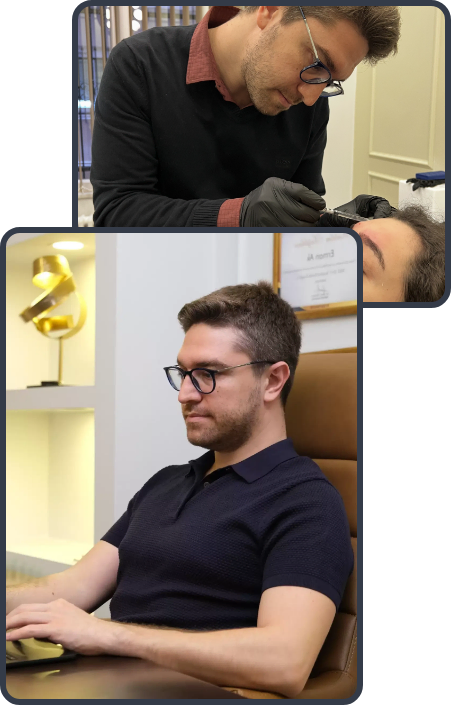Facial aesthetics encompass surgical and non-surgical methods designed to create a more balanced, youthful, and natural appearance. These procedures — including rhinoplasty, jawline contouring, fillers, and Botox — are tailored to each individual.
Facial aesthetic surgeries deliver more defined results, particularly in the nose, eyelid, and chin regions. These operations are chosen for both aesthetic enhancement and functional improvement. The scope of surgery is determined based on the patient’s needs.
Non-surgical facial aesthetic methods such as fillers, Botox, laser, and radiofrequency treatments stand out for their quick completion and short recovery time. This allows individuals to achieve a natural rejuvenation and return to their daily routines swiftly.
Personalized planning is the key to achieving natural results in facial aesthetics. Since every face has a unique structure, the techniques used are determined through a detailed analysis by a specialist. This ensures both an aesthetic and healthy appearance.
What Is Facial Aesthetics?
Facial aesthetics refers to all surgical and non-surgical procedures aimed at harmonizing facial features, restoring symmetry, and achieving a younger, more balanced appearance. These treatments can target various areas such as the nose, chin, cheeks, eye area, and forehead. Facial aesthetics are chosen not only for cosmetic reasons but also to correct certain functional issues.
What Are the Types of Facial Aesthetics?
Facial aesthetics include a range of procedures designed to correct, rejuvenate, or balance facial features. Depending on the person’s age, skin structure, and aesthetic expectations, different techniques may be applied. Here are the most common types of facial aesthetic procedures:
What Can Be Done for the Upper Face and Eye Area?
The upper part of our face, meaning the forehead, eyebrows, and eyes, is the area that most reflects our mood. Whether a person looks tired, angry, or energetic is first understood from here. The structures in this area are so interconnected that thinking of one independently from the other often misleads us.
For example, many people think, “My eyelids are too droopy,” while the real issue may be the low position of the eyebrows. Without us realizing it, our body compensates for this by constantly contracting the forehead muscles to keep the eyebrows lifted. If the sagging skin is removed only with an Upper Eyelid Aesthetic Surgery without this analysis, the forehead muscles may relax, thinking “my job is done.” This can cause the eyebrows to drop further, resulting in an even more tired expression. That’s why viewing this area as a whole and determining the right strategy is the first step toward a successful result.
What Problems Does a Forehead Lift Surgery Solve?
Forehead Lift Surgery is a procedure that elevates the eyebrows that have dropped over time, giving the eyes a more open and bright appearance, and softens the deep lines on the forehead and between the eyebrows. This surgery provides the person with a younger and more positive expression. Sometimes it is not only an aesthetic need but also a functional one. It is quite common for drooping eyebrows and accumulated skin to narrow a person’s field of vision.
Since everyone’s anatomy is different, there is no single forehead lift technique. The method to be applied is specially chosen according to the patient’s needs. The main techniques are:
- Endoscopic Forehead Lift
- Coronal Forehead Lift
- Pretrichial (Hairline) Forehead Lift
- Direct Brow Lift
In the endoscopic technique, a few tiny incisions are made in the scalp, and a camera is used to lift the forehead without leaving a visible scar. The coronal method is more traditional and provides a strong result in severe sagging cases but may move the hairline slightly backward. The pretrichial method, performed right in front of the hairline, allows not only for lifting the eyebrows but also for shortening a high forehead. The direct brow lift is a technique performed directly above the eyebrows, preferred mainly in cases of asymmetry or for specific patient groups.
What Is the Purpose of a Temporal Lift Surgery?
Sometimes, the entire eyebrow does not droop. Only the outer corner, or tail, of the eyebrow may turn downward. This causes excess skin to accumulate at the outer corner of the eyes, giving the person a constantly sad expression. The Temporal Lift Surgery targets this problem with a more minimal intervention. In this procedure, which is not as extensive as a full forehead lift, a small incision hidden within the hair at the temple area is used to lift only the outer part of the eyebrow upward. The recovery period is shorter, and it is particularly effective in correcting the skin accumulation around the eyes and the so-called “crow’s feet” wrinkles.
Why Is Upper Eyelid Surgery Performed?
Excess skin, puffiness, and looseness that develop over time on the upper eyelids make a person look older and more tired than they actually are. Upper Eyelid Surgery is a procedure that removes this excess skin and, if necessary, protruding fat pads to give the eyes a fresher, more lively, and youthful appearance. The reasons for this surgery can be divided into two main categories.
Aesthetic reasons include:
- A heavy and tired appearance of the eyes
- Loss of the natural eyelid crease
- Excess skin that makes makeup application difficult
Functional reasons include:
- Excess skin restricting the visual field
- The constant need to raise the eyebrows to see properly
- Headaches and eye fatigue caused by this effort
During the operation, the incision is made along the natural crease of the eyelid, making the scar almost completely hidden. The amount of skin to be removed must be planned with millimetric precision, as removing too much skin can lead to serious problems such as the eyes not closing completely. Therefore, preoperative evaluation is of vital importance.
What Is the Modern Approach to Lower Eyelid Surgery?
Lower Eyelid Surgery is one of the best examples of the change in the philosophy of facial surgery. The old logic was simple: cut and remove the bags and excess skin under the eyes. However, it was later understood that this approach led to a hollowed, sunken, and “operated” look over time.
The modern philosophy is based on the principle of “don’t remove it, reposition it.” We now know that the fat pads that cause under-eye bags are actually very valuable. Instead of removing them, we can spread them over the hollow area called the “tear trough,” just like a quilt, eliminating the bag while filling the hollow. This creates a smooth, uninterrupted, and youthful transition between the cheek and under-eye area. The main issues addressed by lower eyelid surgery are:
- Under-eye bags
- Tear trough hollowing
- Excess skin and fine wrinkles
- Irregularity in the cheek–eyelid junction
Depending on the patient’s condition, this surgery can be performed either just below the eyelashes or from inside the eyelid, leaving no external scar.
How Can the Effects of Time on the Mid and Lower Face Be Reversed?
The mid and lower parts of the face are where the most dramatic signs of aging are seen. The cheekbones lose volume, the cheeks sag, the lines extending from the nose to the mouth become deep grooves, and most importantly, the jawline loses its sharpness.
Why Should Face and Neck Lift Be Considered Together?
The neck is like a cloak for the face; every movement and change in the face directly affects it. Anatomically, the SMAS layer, which is the support system of the face, continues seamlessly into the platysma muscle in the neck. Therefore, when the cheeks sag, this sagging accumulates along the jawline, creating what we call the “jowl” or “bulldog cheeks,” disrupting the jaw contour. Performing only a Neck Lift Surgery is often insufficient and artificial since it does not address the main source of sagging in the face. It’s like pulling only the edge of a tablecloth—wrinkles remain in the center. For the most natural, harmonious, and lasting results, the face and neck are generally treated as a single aesthetic unit and rejuvenated together.
Which Area Does a Mid-Face Lift Surgery Rejuvenate?
One of the key features of a youthful face is the fullness over the cheekbones. With age, this tissue, called the “malar fat pad,” shifts downward and inward. Mid-Face Lift Surgery targets this sagging cheek tissue. The goal is to reposition it back where it belongs—over the cheekbone. This restores cheek fullness, supports the under-eye area, and reduces the depth of the nasolabial folds. It plays a key role in restoring the desired youthful “V” shape to the face. The surgery is usually performed through incisions under the lower eyelids or endoscopically through the temples.
What Makes the Deep Plane Facelift Technique Different?
The main goal of facelift surgery is to tighten the SMAS layer—a supportive muscle-fibrous tissue layer under the skin. In traditional techniques, this layer is tightened without being separated from the deeper tissues beneath it, much like folding and stitching a fabric onto itself. These methods are safer and less invasive.
The Deep Plane Facelift, however, works on a completely different principle. In this technique, dissection proceeds through the natural space beneath the SMAS layer. This allows the surgeon to directly visualize and release the retaining ligaments responsible for facial sagging. The skin, SMAS layer, and facial fat pads are lifted together as a single unit.
The advantages of the Deep Plane technique include:
- More effective in correcting midface and cheek sagging.
- Provides more noticeable improvement in nasolabial folds.
- Results are more natural and longer-lasting.
- Minimal risk of a “pulled” facial appearance since there is no surface tension.
On the other hand, since it involves working in a deeper anatomical plane, it requires greater surgical experience, is technically more challenging, and has a slightly longer recovery period.
What Issues Does a Neck Lift Surgery Correct?
The neck is one of the areas that most reveals our age. Neck Lift Surgery comprehensively addresses the signs of aging in this area. The problems targeted by the surgery include:
- Excess fat in the double chin area
- Loose skin sagging under the chin
- Vertical muscle bands in the middle of the neck (“turkey neck” appearance)
- Loss of jawline and neck angle definition
In this operation, hidden incisions are usually made under the chin and behind the ears. Excess fat is removed, the loosened platysma muscle is tightened in the center to create an internal corset, and finally, excess skin is excised to restore a sharp, youthful contour to the neck and jawline.
What Are the Contouring Procedures That Improve Facial Outlines?
Sometimes, the issue is not sagging but the basic structure and proportions of the face. These procedures are performed to give the face sharper lines, better balance, and more attractive contours.
Who Is a Suitable Candidate for Buccal Fat Removal (Bichectomy)?
Buccal Fat Removal (Bichectomy) involves removing the buccal fat pads, which add fullness to the cheeks, through an incision inside the mouth. It is especially popular among people with naturally round faces who desire a more sculpted, “Hollywood cheek” appearance. It enhances the definition of the cheekbones and jawline.
However, there is an important point to consider before deciding on this procedure. As we age, our faces naturally lose fat and volume. While a bichectomy can provide great results at a young age, the absence of these fat pads may cause the face to appear hollow and aged earlier in life—especially in the 40s and 50s.
Ideal candidates for bichectomy:
- Structurally full and round cheeks
- Desire for prominent cheekbones and a defined jawline
- Stable body weight
Long-term considerations:
- Natural facial volume decreases with age
- The procedure is irreversible
- There is potential for a hollow appearance later in life
Therefore, the decision for bichectomy should not be made based on trends but through a detailed analysis of the person’s facial anatomy and a full understanding of the long-term outcomes.
What Kind of Change Does Chin Augmentation Provide?
The beauty of our profile depends on the harmony between the structures of our face. No matter how beautiful the nose is, if the chin is recessed or small, the profile balance is disrupted. Chin Augmentation (Genioplasty) aims to restore this balance by altering the size, shape, and position of the chin.
There are two main methods:
- Chin implants
- Bone osteotomy (Sliding genioplasty)
In the implant method, prostheses made of materials such as silicone are placed over the chin bone. This is a practical way to extend the chin forward. Bone osteotomy is a more comprehensive technique where the chin bone is precisely cut and fixed in its new position with a plate and screw system. With this method, not only can the chin be moved forward, but it can also be moved backward, lengthened, shortened, or its asymmetry corrected. Thanks to modern 3D planning technologies, these surgeries now offer very precise and predictable results.
What Is the Purpose of a Lip Lift Surgery?
As we age, the skin distance between the pink part of the upper lip and the base of the nose (the philtrum) increases. This causes the lip to thin, roll inward, and hide the upper teeth when we are not smiling. It gives the face an older and more serious expression. The Lip Lift surgery is designed to correct this problem. A small amount of skin is removed through an incision hidden in the natural creases under the nose. The aesthetic results achieved with this simple procedure include:
- Shortening of the distance between the upper lip and nose
- A fuller and more visible pink part of the upper lip
- Slight upward rotation of the lip corners
A more youthful smile aesthetic is achieved with 1–2 mm of visible upper teeth at rest.
Is It Possible to Restore Lost Facial Volume?
Facial rejuvenation is like assembling pieces of a puzzle. Lifting procedures tighten sagging skin, and contouring procedures correct proportions. But one piece is still missing: volume. As we age, even our bones lose density, and our deep fat pads shrink. Without replenishing these deficits, true rejuvenation cannot be achieved.
Why Is Facial Fat Grafting So Valuable?
Facial Fat Grafting is the most natural and effective way to restore this lost volume. The main steps of the procedure are simple:
- Harvesting the fat
- Purifying the fat
- Injecting the fat
Fat is taken from the patient’s own abdomen or hips, processed into pure, living fat cells, and then injected into areas of facial volume loss such as the temples, cheekbones, cheeks, under-eye area, and nasolabial folds.
The greatest strength of this method lies in using the patient’s own tissue. Therefore, there is no risk of allergy or foreign body reaction. Although a portion of the injected fat is absorbed by the body, the surviving cells continue to live permanently, providing long-lasting fullness. But that’s not all. Fat tissue, containing millions of stem cells, acts not only as a filler but also improves the quality of the overlying skin—adding radiance, vitality, and freshness. For this reason, when combined with other surgical procedures, Facial Fat Grafting elevates the overall results to a whole new level, making it an indispensable component of modern facial rejuvenation.



